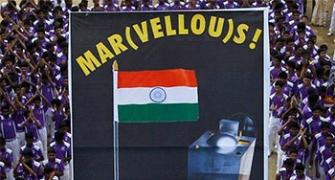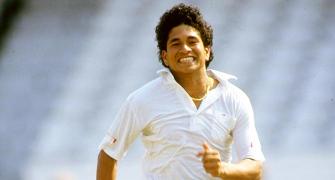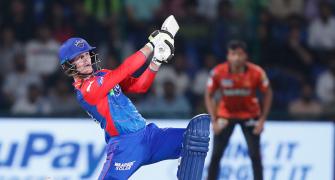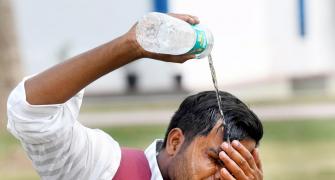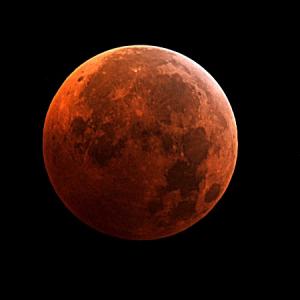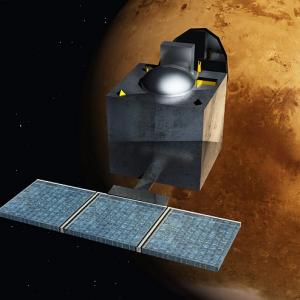It has already tasted success with the moon mission and Mangalyaan. Is man in space the next frontier for ISRO?

On a long table in the office of K Radhakrishnan, the chairman of the Indian Space Research Organisation, are piles and piles of letters and postcards, and a couple of banners filled with signatures, rolled up like scrolls. Sent by schoolchildren from all over the country after the success of the Mars Orbiter Mission, officials at the apex space agency are now trying to figure out how to reply to the hundreds of these congratulatory greetings. “On the day of the insertion (into the Martian orbit), we had asked children to watch it in their schools. We wanted to carry the entire nation with us on the journey, and I think we were able do that,” says Radhakrishnan who took over the reins of ISRO in 2009.
The encomiums may still be pouring in for the mission, successful at the very first attempt and achieved on a shoestring budget of Rs 450 crore, but the agency has moved on to new missions.
All eyes will soon be on the Geosynchronous Satellite Launch Vehicle Mark III, scheduled to lift off by the middle of next month. There was a time when GSLV launches were a thorn in ISRO’s side, after multiple failures, but that jinx seems to have been broken in January, with the successful launch of GSLV-D5. With the Mark III, ISRO would be able to launch four-tonne satellites into orbit, a huge improvement over GSLV’s 2.2-tonne capability and commercial implications. “This mission is an experimental flight with a passive cryogenic stage,” says Radhakrishnan at the space agency’s headquarters in Bengaluru. The cryogenic stage, which is more complex but also more powerful and efficient compared to solid and liquid propellant stages, is still being developed; when complete, the engine would be three times more powerful than those used earlier, he adds.
Once it reaches an altitude of 120 kilometre and a velocity of nearly 5.3 kilometre per second, the Mark III will hurtle down into the Bay of Bengal like a projectile. The experimental flight has another critical task: to test the re-entry characterisation of a crew module that would be used for India’s human spaceflight mission. The module, designed to carry two or three members, and developed at the Vikram Sarabhai Space Centre in Thiruvananthapuram, would be similar to what would be used in the future. “The velocity will have to be brought down to seven metres per second as it splashes into the sea, using a parachute system. It will then have to be located and brought back to land, and we will know how effective the thermal protection system in the crew module is,” says the chairman.
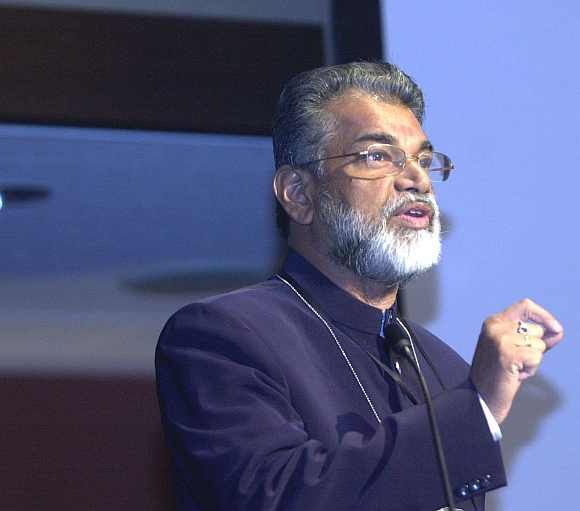 To the layman, there is perhaps nothing as fascinating as the idea of sending humans into space ever since Yuri Gagarin’s successful attempt in 1961. In India, preparation began in 2006-07 with a study, which estimated the cost of sending a two-member crew in orbit around Earth and bringing them back safely after a stay of a week at Rs 12,500 crore. In the years since, some progress has been made in the critical technologies needed for the flight, though the programme itself has not officially been taken up. Several changes have also been made to the original mandate, with the module now designed to take up to three people and the decision to use a Mark III as the launch vehicle.
To the layman, there is perhaps nothing as fascinating as the idea of sending humans into space ever since Yuri Gagarin’s successful attempt in 1961. In India, preparation began in 2006-07 with a study, which estimated the cost of sending a two-member crew in orbit around Earth and bringing them back safely after a stay of a week at Rs 12,500 crore. In the years since, some progress has been made in the critical technologies needed for the flight, though the programme itself has not officially been taken up. Several changes have also been made to the original mandate, with the module now designed to take up to three people and the decision to use a Mark III as the launch vehicle.
One of the biggest challenges will be to ‘human rate’ the vehicle carrying the crew module or ensuring that it is highly reliable because, as former ISRO head U R Rao wryly observes, many people may be dying on the roads every day but even a single loss of human life in a space mission would be unacceptable. The actual flight could take another seven to eight years before which the developmental flight of GSLV Mark III would take place, environmental control and life support systems codified, and flight suit and crew escape module developed. The developmental flight of GSLV Mark III is scheduled for 2016-17.
In a field near Salem in Tamil Nadu, rocks have been pulverised to varying degrees and converted into 50 tonnes of soil to resemble the terrain found on Moon. This is where the indigenously developed rover, which will be part of Chandrayaan-2, is being tested. To simulate the gravity on Moon, a helium balloon lifts five-sixths of the rover's weight. The lander is also being developed and the mission is scheduled to be launched by GLSV in 2016-17.
One of the challenges of the lunar mission, says project director M Annadurai, is to ensure the landing is soft, unlike with Chandrayaan-1. “The equipment has to be safe and the rover has to come out,” says Annadurai who was also the project director for the previous lunar mission in his capacity as programme director for Indian Remote Sensing & Small, Science and Student Satellites. Chandrayaan-2 was originally meant to carry a rover and lander developed by Russia but with its Phobos mission failing and a shift in its space programme, it was decided to make it completely indigenous.
Annadurai is also helming the Aditya mission, a satellite which would act as a solar observatory, and is officially scheduled for launch in 2016-17. “We will be going to a point 1.5 million kilometres away from Earth, from which we will observe the sun constantly,” says Annadurai, who has been with ISRO since 1982. “Technically, this is a very challenging mission. Normally, any satellite will go around a mother planet but this will be at a point where the gravity of the sun and the Earth will play a role to keep the satellite in place,” he says.
The Lagrangian Point, as it is called, is named after 18th century mathematician Joseph-Louis Lagrange, informs former ISRO chairman Rao. Rao retired in 1994, but is involved in projects when he is asked (“without any fee”, he adds with a chuckle). The original idea had been to have a satellite at an orbit of 600 km above Earth which would carry one instrument but this scope was later altered. Rao, now in his 80s, says he was asked to step in when the weight of the instrument kept increasing, which, to him, was unacceptable. “Space scientists have to be absolutely accurate; you can’t keep doubling the weight like that!” he says. Since then, it was decided that a bigger satellite would be needed and a number of reviews have been held.
One of the instruments would be used to study the solar corona, the region around the sun's surface, because so little is known about it. “At the top of the photosphere, the temperature is only 6,000 degrees Celsius but when you go down, it’s 2 million degrees. So how does temperature flow, from low to high? We have no way of measuring what’s happening,” says Rao.
At an event in Delhi on Thursday, ISRO scientists also said a rocket to Mercury and another mission to Mars are being considered, according to a report in Mint. Next year will also see the launch of Astrosat, a multi-wavelength astronomy mission carrying multiple instruments to study celestial sources.
If successful, these would be important achievements for ISRO, which began assembling a satellite in industrial sheds in Peenya in Bengaluru, before the present-day campuses were allotted. Rao reminisces about how even a church in Kerala was co-opted as an office because there was no other building in the village that could be used. “The bishop gave us permission, provided we left the pulpit alone, so we placed a bouquet there and began work!” he says.
While ISRO has come a long way from those days, the spirit of frugality continues, as seen in the cost of the Mars mission. “The frugality of MOM has become a subject of study by management schools and our own specialists,” Radhakrishnan says. The Rs 450-crore budget included the cost of the Polar Satellite Launch Vehicle, the spacecraft, upgrading the deep space network, operational expenses and payments to NASA for using its ground stations. One factor that helped curtail costs was using “the heritage and pedigree of previous satellite systems available to us.” The development was also done in just four years. The Maven, while it has a much wider scope, took 11 years, and was also NASA’s 22nd mission to Mars.
No discussion is complete without a reference to China and the ‘space race’ but Radhakrishnan emphasises that while China has made good progress in human space flights as this was something it had been pursuing since the ’60s, each country has its own strengths and priorities. “Ours is space application; we have been very clear about that. And we are the best there.”
MUST READ: It's time we set our sights beyond Mars
Radhakrishnan’s tenure comes to an end next month, and it has had its share of controversies after successive GSLV failures and an ugly wrangle involving former chairman Madhavan Nair who alleged that ISRO had “gone to the dogs” after his fellow-Malayali took over. Those days now seem like water under the bridge and Radhakrishnan says a systematic succession plan and leadership grooming programme has been in place since February 2010, perhaps the result of his degree from the Indian Institute of Management Bangalore. “For each ISRO centre, there is a succession plan in place, and it cannot be just one person - there have to be at least a couple of people.” He adds that if he wants to be known for anything it would be for grooming young people, “and not for a couple of missions.”
Successful missions, though, apart from boosting the morale of the scientists at ISRO, have improved the public perception of the space agency itself, which, in turn, has led to a flood of job applications. “Over 250,000 people have applied for 200 vacancies. Our people are struggling to screen so many applications,” says Annadurai. There was a lull in 2007-08 but missions like Chandrayaan have enthused people, he adds. “Even those who work in information technology acknowledge the importance of having a sense of achievement, which is possible to get in ISRO.”


